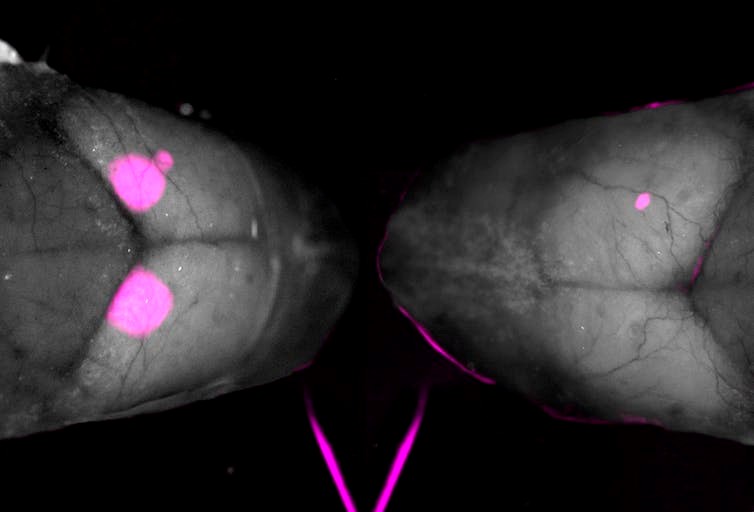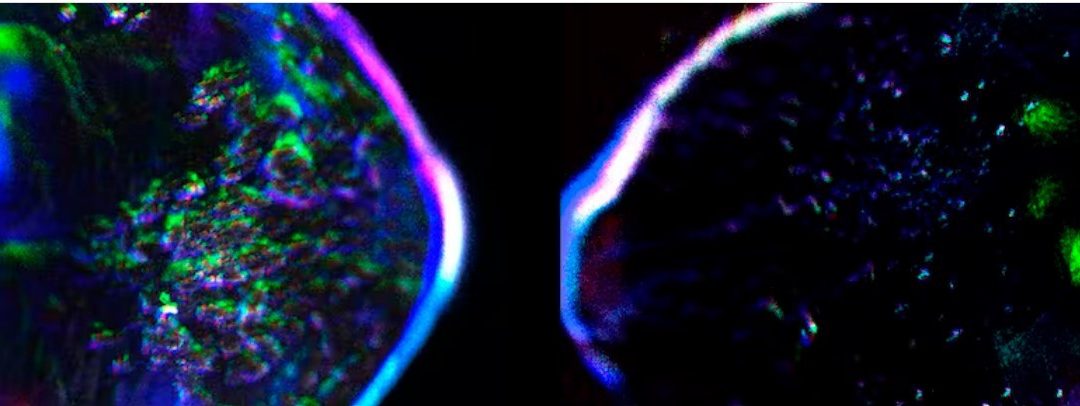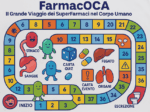Response to a tactile stimulus in the brain of a mouse in which retinal waves have been blocked (left) and in a control mouse (right). IN, CSIC-UMH
Can you imagine if every time you touched something -or something touched you- you had a visual experience? Well, that is precisely what happens before birth. Our lab has discovered that a tactile stimulus in the mouse embryo can simultaneously activate the areas of the cerebral cortex dedicated to touch and vision. In other words, the senses of touch and sight are intermingled before birth
Separated at birth
In order to correctly process stimuli from the outside, our brain needs to arrange the information into separate neural circuits specific to each sensory modality. Like passengers in a train station, sensory stimuli must follow specific neural pathways to reach their destination.
However, this is not the case from the start. Our team has shown that these pathways do not emerge separately, since in the developing brain a stimulus from one sensory modality eventually reaches multiple destinations. Thus, a tactile stimulation of the whiskers of the mouse embryo evokes a multimodal response. That is to say, it simultaneously activates the somatosensory and visual cerebral cortex.
Our lab had shown in a previous study that the embryonic brain is already able to process tactile stimuli. Nevertheless, we wanted to determine whether the brain circuits process this information separately from birth, or whether there is some overlap with other sensory modalities.
This multimodal (encompassing more than one sense) response is observed in mouse embryos on the last day of gestation, but disappears at birth and becomes unimodal. This process occurs during a time window close to birth in a brain structure called the superior colliculus. Continuing the railway simile, in this structure the senses split off to follow different tracks.
But what triggers this change?
Looking for a signal
Since the sense of vision develops later than the sense of touch, we wanted to test whether activity waves originating in the retina could be responsible for the separation of the circuits.
Although mice do not open their eyes until the second week postpartum, the retina starts to have spontaneous activity in the form of waves from the embryonic stage. These waves of neural activity propagate through brain circuits that will be traversed by visual signals from the outside in the future. But their function, especially in the embryo, is poorly understood.
By using pharmacological and in vivo calcium imaging techniques, we have shown that the first waves of activity spontaneously generated in the retina are the signal that the colliculus needs to separate the circuits.

In short, the senses of touch and sight are not independent by default, but need the arrival of retinal activity to separate them. In fact, when we specifically block this first phase of retinal activity, the somatosensory and visual circuits remain intermingled for a period extending into the postnatal phase.
This protraction of the multimodal phase, caused by the transient blocking of the first waves of retinal activity, is in itself sufficient to generate permanent disturbances in the visual pathway, which are likely to have serious consequences on the capacity of the animal to process visual stimuli.
For instance, the segregation of information from each eye, necessary for the correct processing of the visual field, is impaired, and the superior colliculus maintains a mixed identity, not separated into layers by modality, as occurs in a healthy individual. An important contribution of this work, therefore, is the discovery of a limited temporal window for the separation of the visual systems from the somatosensory systems, as any delay in this division causes long-lasting changes in the organisation of the visual circuits.
New function for an old structure
This study also provides fascinating insights into the superior colliculus, an evolutionarily ancestral structure. As it is highly conserved in vertebrates, it has been studied in several species and its function was thought to be completely described.
The superior colliculus performs sensorimotor integration to mediate eye movements and orientation responses. This study goes further and reveals that the superior colliculus exerts master control during early development over cortical specification and the configuration of sensory circuits.
We therefore believe that it is not possible to understand how new and complex structures such as the cerebral cortex are formed without taking into account their relationship to phylogenetically older structures.
Source: The Conversation
Teresa Guillamon Vivancos
Postdoctoral Researcher, Neurodevelopment, Miguel Hernández University
Guillermina López-Bendito
CSIC Research Professor, Miguel Hernández University










